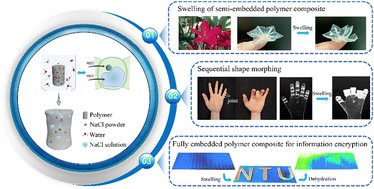Bio-inspired facile strategy for programmable osmosis-driven shape-morphing elastomer composite structures†
Abstract
Achieving programmable and reversible deformations of soft materials is a long-standing goal for various applications in soft robotics, flexible electronics and many other fields. Swelling-induced shape morphing has been intensively studied as one of the potential mechanisms. However, achieving an extremely large swelling ratio (>1000% in volume) remains challenging with existing swellable soft materials (e.g., hydrogels and water-swellable rubbers). Inspired by the shape change enabled by the osmosis-driven swelling in living organisms, herein, we report a polymer composite system composed of fine sodium chloride (NaCl) particles embedded in Ecoflex00-10 polymer. This Ecoflex00-10/NaCl polymer composite can achieve controllable volumetric swelling up to 3000% while maintaining a relatively high elastic stiffness. We demonstrate that this swellable polymer composite can serve as an active component to drive the shape morphing of various structures. By controlling the geometric design and the fraction of the NaCl particle, morphing structures capable of deforming sequentially are created. Finally, by encapsulating 3D printed polymer composite patterns using water-permeable PDMS membrane, a programmable braille with visual and tactile regulation is demonstrated for the purpose of information encryption. Our study provides a facile approach to generate customizable shape-morphing structures, aiming to broaden the range of techniques and applications for morphing devices.

- This article is part of the themed collection: Most popular articles from Nanyang Technological University, Singapore


 Please wait while we load your content...
Please wait while we load your content...